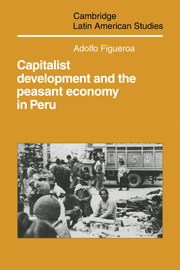Book contents
- Frontmatter
- Contents
- List of tables and figures
- Acknowledgments
- 1 Introduction
- 2 Scope and method
- 3 The economic unit and economic organization
- 4 Production and exchange
- 5 The level and structure of peasant income
- 6 The economic behavior of the peasant family
- 7 Stagnation in the peasant economy and the role of demand
- 8 Economic crisis and the peasant economy, 1975–1980
- 9 Conclusions: reality, theory and policy
- Appendixes
- Notes
- Bibliograph
- Index
- CAMBRIDGE LATIN AMERICAN STUDIES
9 - Conclusions: reality, theory and policy
Published online by Cambridge University Press: 04 August 2010
- Frontmatter
- Contents
- List of tables and figures
- Acknowledgments
- 1 Introduction
- 2 Scope and method
- 3 The economic unit and economic organization
- 4 Production and exchange
- 5 The level and structure of peasant income
- 6 The economic behavior of the peasant family
- 7 Stagnation in the peasant economy and the role of demand
- 8 Economic crisis and the peasant economy, 1975–1980
- 9 Conclusions: reality, theory and policy
- Appendixes
- Notes
- Bibliograph
- Index
- CAMBRIDGE LATIN AMERICAN STUDIES
Summary
This study has been concerned with the functioning of the peasant economy in today's Peru. This particular reality has been neglected in the economic studies on Peru, in spite of its great significance in the social system. The peasant economy has remained a reality without a theory. In this study the basic traits of the peasant economy have been investigated and then utilized to lay down the principal analytical coordinates of its prevailing economic rationality. The peasant economy has also been placed in the context of capitalist development in order to analyze its changing role in the economic system. In this final chapter a summary of our empirical findings and theoretical interpretations are presented. This will be done in terms of the hypotheses advanced in Chapter 2. Because a theoretical basis has been reached, economic policies are also discussed.
Poor but efficient
The economy of the peasant communities in the Peruvian sierra is organized in family units, which are the units of production and consumption. In the case of the southern sierra, the most economically depressed area, the average size of the peasant family varies between four and five members; the average total labor force is four people and the adult labor force is two. The peasant family depends upon resources of cultivable land, and usually has no more than five hectares in area in addition to access to natural pastures, communally held. The cultivable land is composed of parcels, the average number of which varies between ten and 80, depending upon the community. Regarding livestock, a peasant family typically has seven sheep, two heads of cattle and one horse.
- Type
- Chapter
- Information
- Capitalist Development and the Peasant Economy in Peru , pp. 114 - 125Publisher: Cambridge University PressPrint publication year: 1984



